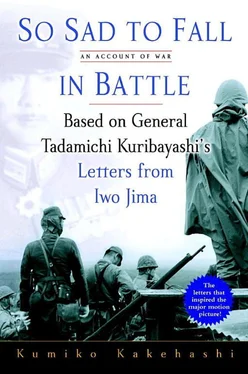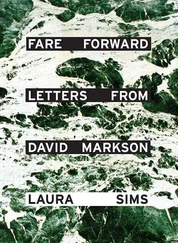Kuribayashi had commanded from here, right from the start of the softening-up campaign of naval barrages and air raids that preceded the invasion. It was here that he refined his strategy, listened to the reports from the units on different parts of the island, issued his orders, and drafted the reports and telegrams that were sent to the Imperial General Headquarters. There was nothing in the room now and it was bleak and empty, but in those days there must have been a desk for Kuribayashi to work at.
There is a story that an American soldier armed with a flamethrower penetrated as far as the door of this room when the Americans were bearing down on the Command Center in early March 1945.
Kuribayashi, however, was so focused on his work that he didn’t notice and just continued poring over the documents on his desk. The sentry quickly unfurled a military-issue blanket to act as a screen between the American soldier and his commander in chief. “Oh, thanks,” said Kuribayashi, rising to his feet and calmly walking farther into the cave. Overawed by this display of nerve, the American soldier turned on his heel and fled.
The Japanese soldiers recounted this story to one another as an example of Kuribayashi’s courage. It is not clear whether the episode really occurred, but the fact that the story spread by word of mouth in the midst of combat reveals how Kuribayashi was seen by his men: as a splendid commanding officer for whom they were willing to die. The boost such feelings gave them must have gone some way to help them accept the inevitability of death.
Leaving Kuribayashi’s room and proceeding farther down the passageway I suddenly emerged into a big space. The roof was probably around 3 meters high and had half crumbled away to expose the rock beneath. A natural cave that had been enlarged, it felt more like an enormous cellar than a room; supposedly it was used for strategy meetings.
Leading off from the cave in all four directions were passages. Niches just big enough for a single person to lie down had been carved into the walls. You can no longer go down these passages—some are impassable and others have been blocked off with iron bars—but they crisscrossed like a veritable maze and were connected to nine separate entrances and exits.
Kuribayashi’s letters to his family before the American invasion were probably written aboveground rather than down here, but the farewell telegram, the last thing he ever wrote, must have been written here in the Command Center. In the same small and precisely drawn characters and with the same writing paper and pencil that he used for the letters to his family, Kuribayashi composed that telegram here deep underground where the sun could not reach.
After the guide had left, I stood in the center of Kuribayashi’s private room and turned off my flashlight. Suddenly the air felt thick, and the darkness seemed to press heavily down on me from the roof of the cave. Had Kuribayashi ever left the cave to feel the sun on his skin in the thirty-six days between the American landing and the defeat of the Japanese? It is believed that it was early on March 26 that Kuribayashi led the final all-out attack. Had it still been dark then?
Even after the Japanese had been defeated and the Americans had occupied the island, many Japanese soldiers continued hiding out in the defenses and waged a guerrilla war against the Americans. Under cover of night, they would strike at American defenses or forage for food and water. In the daylight hours, they would hide underground, so they were not exposed to the sun for many days, even months.
Survivors told me how, their minds blurred and their bodies no more than skin and bone, as food and water started to run out, they would suddenly get the urge to see the sun before they died, even though it meant that they would be captured as they crawled out of their shelters and so become prisoners of war. Many, however, were trapped belowground and either suffocated or starved to death after the Americans blasted the entrances of the caves they were in.
If you go deep into one of the caves, it doesn’t take long before the oppressive darkness and the heavy, stagnant air make you feel panicky.
I remembered the telegram sent by Rear Admiral Ichimaru Rinosuke, commander of the navy forces: “The enemy are aboveground and friendly troops belowground: that is what is unusual about the battle on Iwo Jima.” And once again I felt keenly just how pitiless a strategy Kuribayashi had chosen.
NOBODY KNOWS HOW MANY underground bunkers were built on Iwo Jima: the number is thought to exceed one thousand, with some historians putting the figure as high as five thousand. Many of the bunkers still remain undiscovered—along with the bones inside them. During the battle, and directly after the capture of the island, the Americans blasted shut the cave entrances or buried entire positions with bulldozers. By the time Iwo Jima was returned to the Japanese it was therefore difficult to pinpoint where things were, and the search is now further complicated by the vegetation that covers the island.
When they started collecting the remains of the dead, the survivors relied partly on memory to find the bunkers in which they had hidden, and partly on the meager extant documentation. The present method involves hacking out a path through the branches of the lead trees and the creeping plants entwined around them, and crawling on hands and knees to find the bunker entrances. Sometimes bulldozers are used to push the upper layer of earth aside and dig out the bunker below. Occasionally, if they find one of the blasting fuses the Americans used to pay out when blowing the bunkers shut, they can follow these until they find the bunker entrance.
The bunkers themselves are often half full of earth. This earth is carefully extracted and sieved to check for remains. Sometimes the dead are almost perfectly preserved.
On the pilgrimage I went on, there was a man who had been orphaned in the war and was visiting the island for the third time. His name was Yamagiwa Yoshikazu, and he and his wife had traveled from Oita Prefecture. His father had died on Iwo Jima. Called up at the age of thirty-nine, he had three children, of whom Yamagiwa, then at elementary school, was the eldest. His widowed mother went through great hardship after the war bringing up three children all by herself, he told me.
In 1984, Yamagiwa had taken part in a visit to collect the remains of the dead. This was in the early days when the practice of families going out and gathering first began in earnest. In the course of about four weeks, they collected the remains of 135 people.
“The caves had been sealed tightly shut for forty years, so there was no oxygen in them. The first thing we did was use a machine to pump in oxygen. Then we roped ourselves up and were lowered down, dangling from the surface. The first cave I went into was 20 meters deep.”
No one is allowed to work inside a cave for more than twenty minutes, Yamagiwa told me, as there are places where the temperature can be as high as 176 degrees Fahrenheit—not to mention the danger of being poisoned by sulfur gas.
Sometimes they could see the bones of the dead, but extreme heat or lack of oxygen prevented them from collecting them, and the sense of guilt made them weep long and hard. The families do not distinguish between the bones of relations and nonrelations. For them, everyone is equal.
When he first started, Yamagiwa told me that he used to wear army-issue cotton gloves for the work, but it was not long before he began to pick up the bones with his bare hands.
“If you’ve got army-issue cotton gloves on, any bones you pick up stick to your hands.”
The bones of someone who has been cremated are smooth, but the bones of a corpse that’s been abandoned and has gone through the process of natural decay are sticky. That is the reason the bones stick fast to gloves. For Yamagiwa, it felt as though the bones were stubbornly refusing to let go of the hand of the person who had at long last come from the homeland to collect them.
Читать дальше












